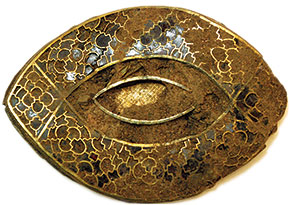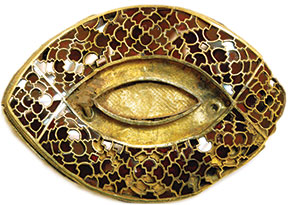
From National Geographic film crews to exciting discoveries by my colleagues, there hasn't been a dull moment. I have been treating several objects, chosen as high-priority pieces and earmarked to be featured in a major exhibition.
One of my favorite pieces has been a beautiful gold object called a lentoid (for its lens shape), with intricate cloisonné cells. It was my first treatment and a rather striking introduction to the Hoard.
The lentoid was clearly designed to impress, with an estimated 239 cloisonné cells, gold backing foils stamped with two different patterns, and a double border of filigree around the outside edge. The cells were heavily caked with soil prior to cleaning, obscuring the distinctive features of the piece.
I began by examining the object and taking note of its condition and construction. Then I took photographs and wrote a brief report to document the object's state before treatment.
The treatment protocol is meticulous. Everything that is removed from the object including soil, corrosion products, and residues, is saved in labeled sample vials for future analysis.
I used a natural thorn in a pin vice to clean the lentoid under high-powered magnification. Water is sparingly used where soil is compacted.
Altogether, 211 garnets remain in the lentoid. Some cells are missing garnets or backing foils, and while this interrupts the design, it also reveals the astonishing intricacy of the object's construction.
In the empty cells, possible remnants of a backing paste exist. This would have bulked up the cells beneath the patterned gold foils into which the cut garnets were precisely set.
Several rivet holes and one intact rivet, seemingly in its original location, indicate that the object would have fastened to a support of some kind. For the present, this object remains a mystery.
Holding the materials from the Staffordshire Hoard feels surreal when you actually focus on the full magnitude of their history and uniqueness. Usually, you are working on such a tiny scale and concentrating on observing every detail. That can be extraordinary in itself, but stepping back to observe the big picture on occasion can be breathtaking.
Some of the most amazing and iconic pieces in the hoard include the folded cross, discovered with its arms bent around some of its original settings and garnets, and a miniature seahorse with intricate filigree spirals. To give a sense of scale, a grain of rice is longer than three of these spirals. The craftsmanship of these pieces is unbelievable. We truly don't know how certain things were accomplished, especially considering the limited technologies available at the time.
The Staffordshire Hoard will be on display at the National Geographic Museum in Washington, D.C., from Oct. 29, 2011, to March 4, 2012.
The internship has demonstrated for me the critical importance of collaboration amongst museum professionals, who are instrumental in working to preserve, understand and showcase these artifacts. I feel a renewed sense of commitment to public outreach after my involvement with tours, blogs and news coverage this summer. People are excited about this find and deserve to be able to access information about their cultural heritage.



Garnet-encrusted gold lentoid shown in its found state — caked in dirt — and after cleaning and treatment by UD graduate student Ellen Promise.